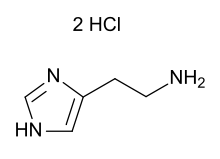Histamine dihydrochloride
Histamine dihydrochloride (INN, trade name Ceplene) is a salt of histamine that is used as a drug for the prevention of relapse in patients diagnosed with acute myeloid leukemia (AML).
 | |
| Clinical data | |
|---|---|
| Trade names | Ceplene |
| License data | |
| Routes of administration | Subcutaneous injection, topical |
| ATC code | |
| Legal status | |
| Legal status |
|
| Identifiers | |
| |
| CAS Number | |
| PubChem CID | |
| ChemSpider | |
| UNII | |
| CompTox Dashboard (EPA) | |
| ECHA InfoCard | 100.000.272 |
| Chemical and physical data | |
| Formula | C5H11Cl2N3 |
| Molar mass | 184.06 g·mol−1 |
| 3D model (JSmol) | |
| |
| |
It is also an FDA-approved[1] active ingredient for topical analgesic use for the temporary relief of minor aches and pains of muscles and joints associated with arthritis, simple backache, bruises, sprains, and strains and is available in over-the-counter (OTC) products such as Australian Dream and Golden Creme.[2] [3]
Use in leukemia
Histamine dihydrochloride is administered in conjunction with low doses of the immune-activating cytokine interleukin-2 (IL-2) in the post-remission phase of AML, i.e. when patients have completed the initial chemotherapy. This combination has been reported to significantly reduce the risk of relapse in AML.[4] The effect is particularly pronounced in patients in their first remission who are below the age of 60.[5]
The combination of histamine dihydrochloride and interleukin-2 was approved for use in AML patients within the European Union in October 2008[6] and will be marketed in the EU by the Swedish pharmaceutical company Meda. The drug is also available through a named patient program in several other countries (excluding the US).
Proposed mechanism of action
Histamine dihydrochloride acts by improving the immune-enhancing properties of IL-2, and laboratory studies have shown that this combination can induce immune-mediated killing of leukemic cells.[7] The treatment (in the form of subcutaneous injections) is given in 3-week cycles by the patients at home for 18 months, thus coinciding with the period of highest relapse risk. The side-effects include transient flush and headache, whereas IL-2 may induce low-grade fever and inflammation at the site of injection. Histamine dihydrochloride has been developed by researchers at the University of Gothenburg, Sweden.
References
- https://www.fda.gov/downloads/Drugs/DevelopmentApprovalProcess/DevelopmentResources/Over-the-CounterOTCDrugs/StatusofOTCRulemakings/UCM077928.pdf
- https://www.australiandream.com/how-it-works/
- https://www.golden-creme.com/
- Brune M, Castaigne S, Catalano J, et al. (July 2006). "Improved leukemia-free survival after postconsolidation immunotherapy with histamine dihydrochloride and interleukin-2 in acute myeloid leukemia: results of a randomized phase 3 trial". Blood. 108 (1): 88–96. doi:10.1182/blood-2005-10-4073. PMID 16556892.
- Romero AI, Thorén FB, Aurelius J, Askarieh G, Brune M, Hellstrand K (September 2009). "Post-consolidation immunotherapy with histamine dihydrochloride and interleukin-2 in AML". Scand. J. Immunol. 70 (3): 194–205. doi:10.1111/j.1365-3083.2009.02303.x. PMID 19703009.
- Committee For Medicinal Products For Human Use: Summary Of Positive Opinion for Ceplene (2008-11-25)
- Hellstrand K, Asea A, Dahlgren C, Hermodsson S (December 1994). "Histaminergic regulation of NK cells. Role of monocyte-derived reactive oxygen metabolites". J. Immunol. 153 (11): 4940–7. PMID 7963557.